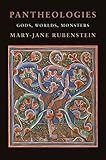Pantheologies : Gods, Worlds, Monsters / Mary-Jane Rubenstein.
Material type: TextPublisher: New York, NY : Columbia University Press, [2019]Copyright date: ©2018Description: 1 online resourceContent type:
TextPublisher: New York, NY : Columbia University Press, [2019]Copyright date: ©2018Description: 1 online resourceContent type: - 9780231189460
- 9780231548342
- 211.2 23
- BL220 .R83 2018
- BL220
- online - DeGruyter
- Issued also in print.
| Item type | Current library | Call number | URL | Status | Notes | Barcode | |
|---|---|---|---|---|---|---|---|
 eBook
eBook
|
Biblioteca "Angelicum" Pont. Univ. S.Tommaso d'Aquino Nuvola online | online - DeGruyter (Browse shelf(Opens below)) | Online access | Not for loan (Accesso limitato) | Accesso per gli utenti autorizzati / Access for authorized users | (dgr)9780231548342 |
Browsing Biblioteca "Angelicum" Pont. Univ. S.Tommaso d'Aquino shelves, Shelving location: Nuvola online Close shelf browser (Hides shelf browser)

|

|

|

|

|

|

|
||
| online - DeGruyter Buddhism and Medicine : An Anthology of Modern and Contemporary Sources / | online - DeGruyter A Śabda Reader : Language in Classical Indian Thought / | online - DeGruyter Sacred Cesium Ground and Isa's Deluge : Two Novellas of Japan's 3/11 Disaster / | online - DeGruyter Pantheologies : Gods, Worlds, Monsters / | online - DeGruyter Fresh Kills : A History of Consuming and Discarding in New York City / | online - DeGruyter Driving Innovation from Within : A Guide for Internal Entrepreneurs / | online - DeGruyter A German Officer in Occupied Paris : The War Journals, 1941-1945 / |
Frontmatter -- CONTENTS -- ACKNOWLEDGMENTS -- PREFACE -- INTRODUCTION THE MATTER WITH PANTHEISM -- PANIC -- 1. PAN -- PANTERRUPTION -- 2. HYLE -- PANFUSION -- 3. COSMOS -- PANCARNATION -- 4. THEOS -- PANDEMONIUM -- NOTES -- BIBLIOGRAPHY -- INDEX
restricted access online access with authorization star
http://purl.org/coar/access_right/c_16ec
Pantheism is the idea that God and the world are identical-that the creator, sustainer, destroyer, and transformer of all things is the universe itself. From a monotheistic perspective, this notion is irremediably heretical since it suggests divinity might be material, mutable, and multiple. Since the excommunication of Baruch Spinoza, Western thought has therefore demonized what it calls pantheism, accusing it of incoherence, absurdity, and-with striking regularity-monstrosity.In this book, Mary-Jane Rubenstein investigates this perennial repugnance through a conceptual genealogy of pantheisms. What makes pantheism "monstrous"-at once repellent and seductive-is that it scrambles the raced and gendered distinctions that Western philosophy and theology insist on drawing between activity and passivity, spirit and matter, animacy and inanimacy, and creator and created. By rejecting the fundamental difference between God and world, pantheism threatens all the other oppositions that stem from it: light versus darkness, male versus female, and humans versus every other organism. If the panic over pantheism has to do with a fear of crossed boundaries and demolished hierarchies, then the question becomes what a present-day pantheism might disrupt and what it might reconfigure. Cobbling together heterogeneous sources-medieval heresies, their pre- and anti-Socratic forebears, general relativity, quantum mechanics, nonlinear biologies, multiverse and indigenous cosmologies, ecofeminism, animal and vegetal studies, and new and old materialisms-Rubenstein assembles possible pluralist pantheisms. By mobilizing this monstrous mixture of unintentional God-worlds, Pantheologies gives an old heresy the chance to renew our thinking.
Issued also in print.
Mode of access: Internet via World Wide Web.
In English.
Description based on online resource; title from PDF title page (publisher's Web site, viewed 29. Mrz 2022)


